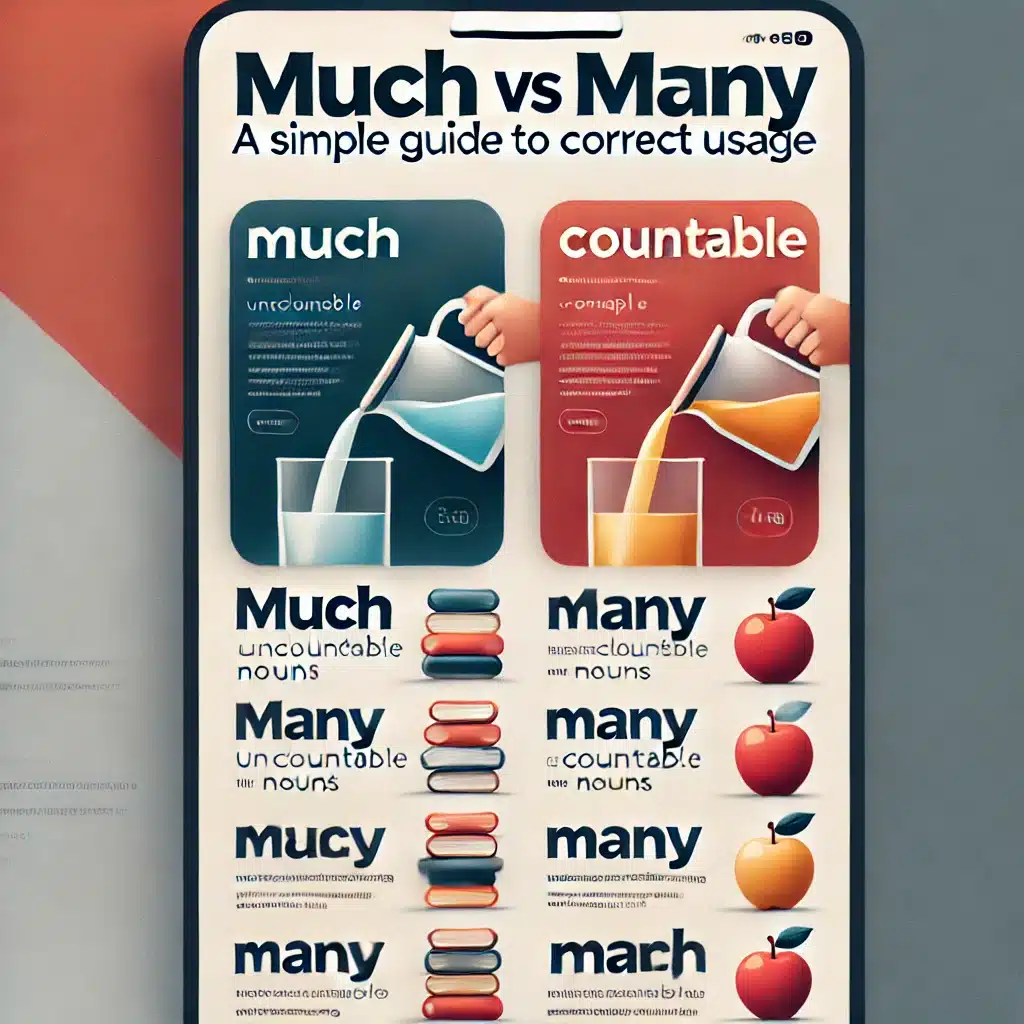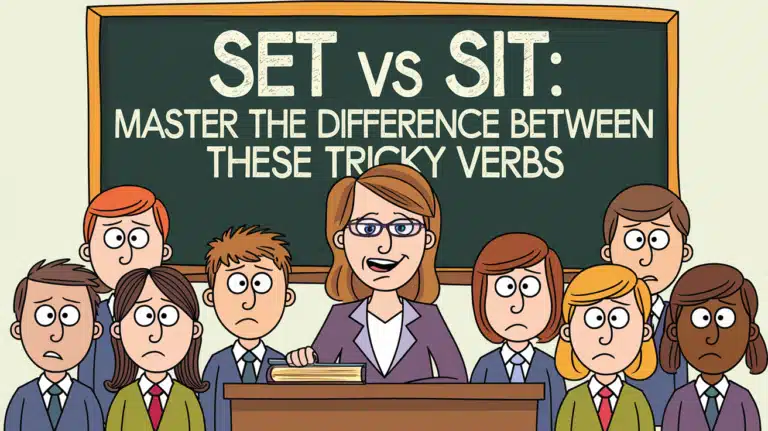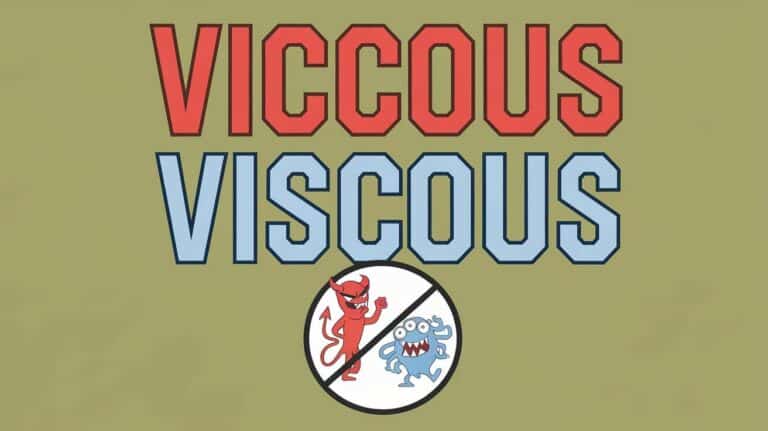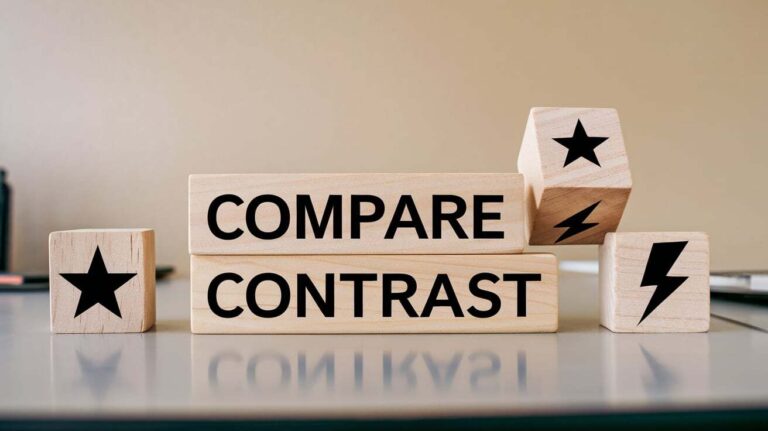Much vs Many: A Simple Guide to Correct Usage
In English, using the words “much” and “many” correctly can be tricky, especially for learners navigating countable and uncountable nouns. Mastering these terms is essential for correct communication in both formal and informal contexts. This guide breaks down their usage with practical examples, clear definitions, and tips to ensure grammatical accuracy.
Understanding the Confusion Between “Much” and “Many”
English learners often struggle with “much” and “many” because both relate to quantities. The confusion arises from:
- Countable vs. Uncountable Nouns: Knowing the difference is crucial for proper grammar usage.
- Overlapping Contexts: Some nouns can feel ambiguous, leading to misuse.
- Abstract Usage: Using “much” and “many” in figurative or abstract contexts adds complexity.
Why Learners Struggle
Many learners find it hard to determine if a noun is countable or uncountable. For example:
- “How much sugar do you take?” (Uncountable)
- “How many cookies do you want?” (Countable)
Common Mistakes
- Saying “How much apples are there?” instead of “How many apples are there?”
- Using “many” with abstract nouns, like “happiness” or “advice,” which are uncountable.
Breaking Down the Basics
What Does “Much” Mean?
“Much” refers to a large quantity of something that cannot be counted individually. It is used with uncountable nouns like water, air, or knowledge.
What Does “Many” Mean?
“Many” refers to a large number of countable items. It is commonly used with countable nouns, such as books, apples, or cars.
The Core Rule: Countable vs. Uncountable Nouns
| Term | Definition | Examples |
|---|---|---|
| Countable Nouns | Things you can count individually. | books, chairs, dogs |
| Uncountable Nouns | Things you cannot count individually. | rice, music, information |
Tip: Always pair “much” with uncountable nouns and “many” with countable ones for writing clarity and correct communication.
When and How to Use “Much”
Formal vs. Informal Usage
- Formal expressions: “Much” is more common in formal writing.
Example: “There isn’t much evidence to support the claim.” - Informal speech: In conversations, “much” is often replaced by phrases like “a lot of.”
Example: “I don’t have a lot of time.”
Examples of “Much” in Sentences
- There isn’t much water left in the tank.
- How much effort does it take to learn a new language?
Exceptions to the Rule
In positive sentences, “much” is less commonly used and often replaced with alternatives.
- Incorrect: “I have much money.”
- Correct: “I have a lot of money.”
When and How to Use “Many”
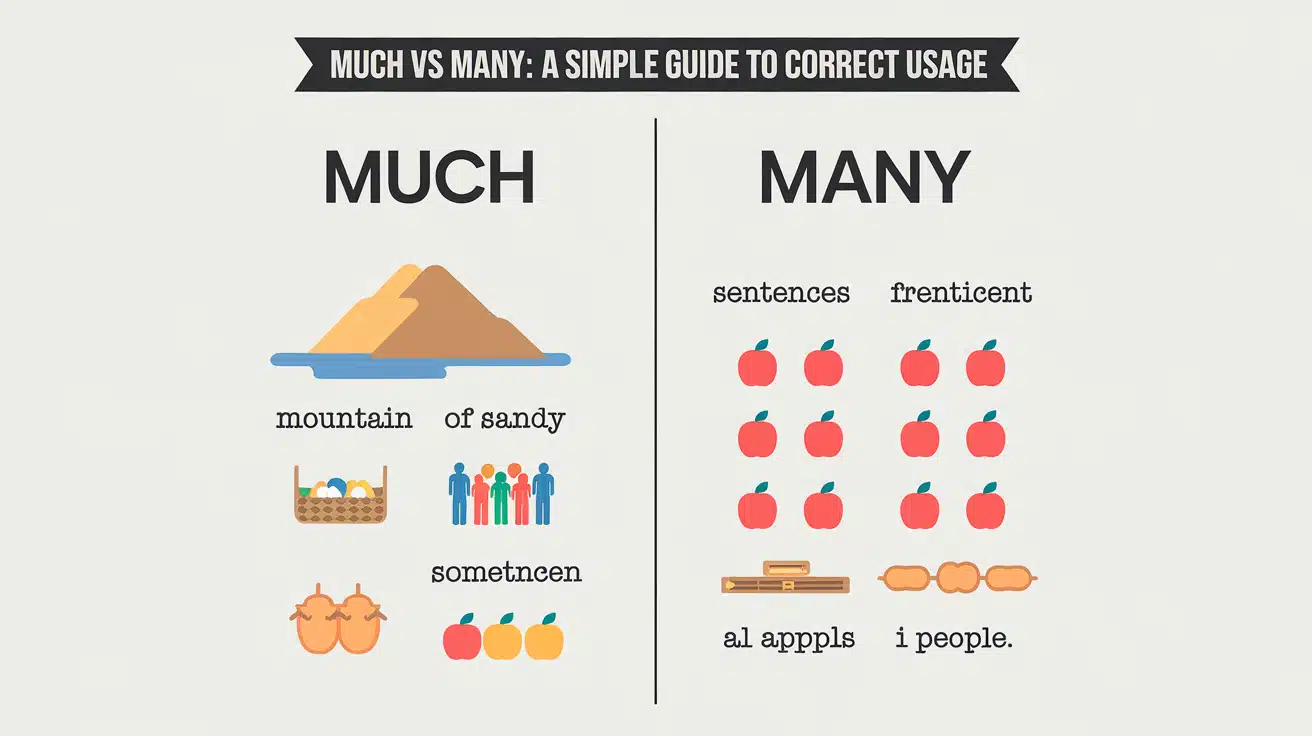
Contexts for “Many” in Everyday Speech
“Many” is widely used in both positive and negative sentences:
- Positive sentences: “I have many friends in this city.”
- Negative sentences: “There aren’t many options available.”
Examples of “Many” in Sentences
- How many books have you read this month?
- There are many reasons to visit this museum.
Exceptions and Edge Cases
Some countable nouns behave unusually, requiring memorization for linguistic tools like idioms.
Example: “Too many cooks spoil the broth.”
Read More About: Trailer or Trailor: Which Spelling Is Correct and Why?
Key Differences Between “Much” and “Many”
| Aspect | Much | Many |
|---|---|---|
| Type of Noun | Uncountable | Countable |
| Examples | water, advice, furniture | chairs, apples, ideas |
| Formal Context | Common | Less common |
| Usage in Speech | Less frequent | Widely used |
Functional Differences
- Use “much” for abstract ideas: “There’s not much love in the air.”
- Use “many” for tangible things: “How many cars are parked outside?”
Overlapping and Challenging Nouns: “Much” or “Many”?
Certain nouns can confuse even advanced learners. Consider these examples:
- “Time” (abstract concept): Use “much.” Example: “How much time is left?”
- “Hours” (specific, countable): Use “many.” Example: “How many hours will it take?”
Advanced Usage of “Much” and “Many” in Different Contexts
Academic Writing
In formal writing, precision is key:
- “There isn’t much evidence to validate the claim.”
- “Many studies have shown similar results.”
Casual Conversations
In everyday speech, alternatives like “a lot of” are popular:
- “I don’t have much patience for this.”
- “There are many things to consider.”
Literary or Poetic Uses
Writers often use “much” and “many” for emphasis or rhythm.
- “Much ado about nothing.” (William Shakespeare)
- “Many hands make light work.” (Proverb)
Exploring the Origins of “Much” and “Many”
Historical Development of “Much”
Derived from Old English “mycel,” meaning “great” or “large.” Over centuries, it evolved to express large amounts or great intensity.
Historical Development of “Many”
Rooted in Old English “manig,” meaning “multitude.” Its use expanded to denote large numbers of discrete items.
Evolution of Usage
Both terms have maintained their core meanings but adapted for modern formal writing and everyday speech.
Visual Comparison of “Much” vs. “Many”
| Term | Countable Nouns | Uncountable Nouns | Examples |
|---|---|---|---|
| Much | Not used | Yes | much water, much advice |
| Many | Yes | Not used | many apples, many reasons |
Quick Reference Guide to “Much” and “Many”
Memory Tricks and Mnemonics
- Use “many” when you can count items individually.
- Use “much” when you can’t count but can measure.
Common Idioms
- “Much ado about nothing.”
- “As many as possible.”
Conclusion: Mastering the Use of “Much” and “Many”
Understanding “much” and “many” boils down to distinguishing between countable and uncountable nouns. By focusing on context, examples, and exceptions, you can achieve grammatical accuracy and natural expression. Practice daily and apply these rules in your writing and conversations to ensure correct usage.
Quote to Remember:
“Good grammar is the foundation of clear and effective communication. Master ‘much’ and ‘many’ to make every sentence shine.”

